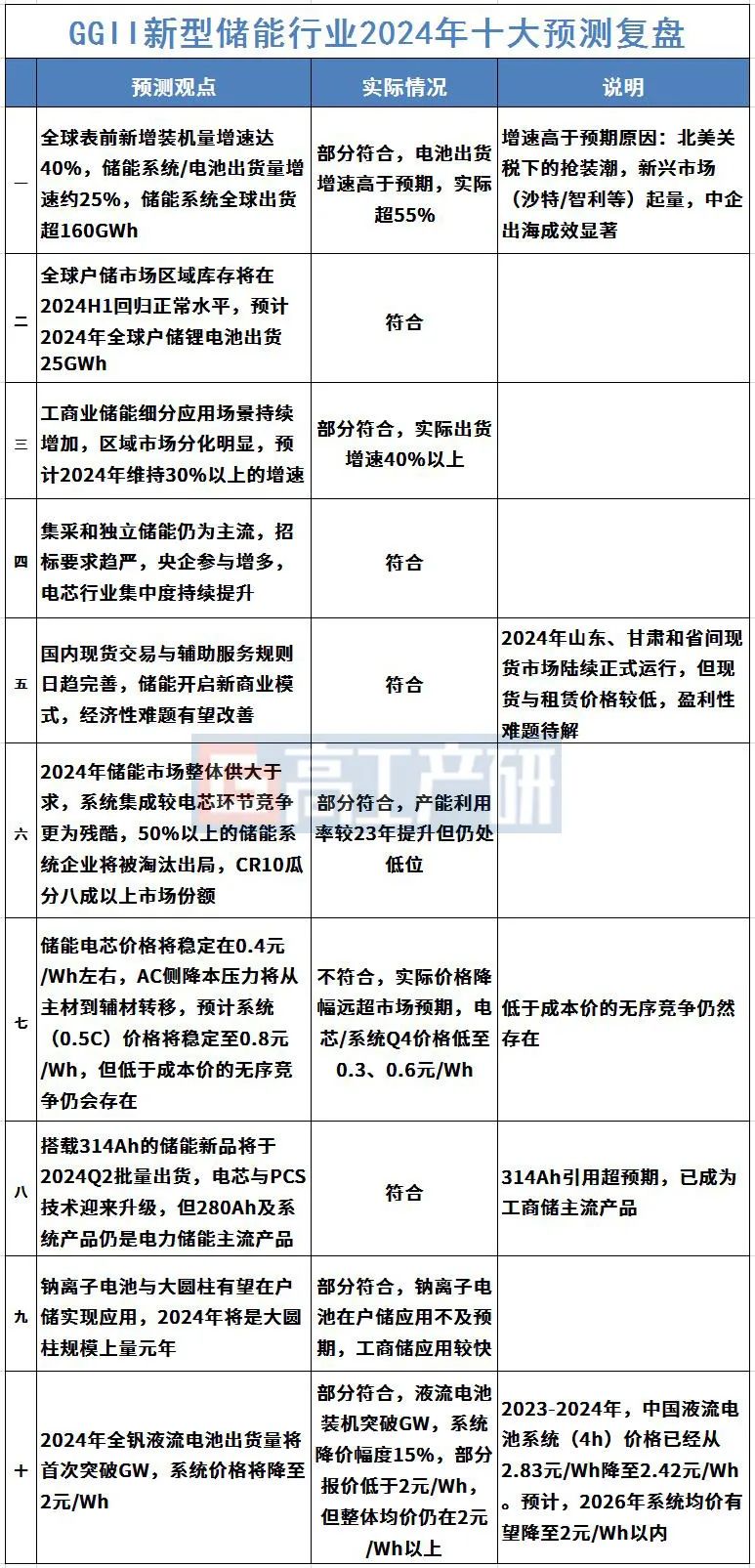Ten Trends Forecast of New Energy Storage Market in 2025 (I)
In 2024, the reshuffle of the energy storage industry intensified, and the low price involution was still not bottomed out. In 2024, the energy storage delivery performance of Tier 1 and tier 2 enterprises doubled year-on-year. In contrast, some cross-border and industry chain-related enterprises have withdrawn or experienced liquidity crisis. Multiple expansion projects have been postponed or canceled, IPO has been terminated, delisting/bankruptcy is rare. The low price of involution extends from domestic to overseas, from cell/integration to auxiliary materials/investment/O & M, deteriorating financing environment, stricter customer requirements, the low price of Youshang involution makes the living space of small and medium-sized enterprises compressed.
In 2024, the global energy storage market blossomed more, making it an inevitable option to go to sea. In addition to traditional Chinese, American, European, Australian and other markets, emerging market demand is rapidly rising. In the big reserve market, the demand for GWh-level large-scale optical storage projects in Asia (India/Philippines/Uzbekistan/UAE/Saudi Arabia), Africa (Egypt/South Africa), and la (Canada/Chile) has emerged. Globalization layout is not only an effective strategy to deal with low-price involution, but also an inevitable choice to face the uncertainty of current market growth.
Looking back on the past 2024, high-tech research energy storage the Research Institute (GGI) once released "GGI: Ten Trends of China's new energy storage market in 2024" at the end of 2023. After a year's review, some viewpoints were still applicable in 2025.

Source: Energy Storage Research Institute of High industrial production (gii), January 2025
GGII predicts ten major trends of the new energy storage market in 2025 through industry sorting and industry research, combined with macro trends and enterprise data:
forecast 1: In 2025, the new installed capacity of global energy storage will exceed 250GWh, and the European market will lead the growth rate. The Middle East, an emerging market, will become the fourth largest installed capacity area for global new energy storage.
In 2024, the total installed capacity of the Front of the Meter (FTM) was about 165GWh, among which the total proportion of China, America and Europe in the core area of energy storage installed capacity still exceeded 90%.
In China, some provinces have completed the 14th Five-Year Plan ahead of schedule, and the unfinished provinces have large installed space in Inner Mongolia, Qinghai, Gansu and other places. It is estimated that the domestic source network side installed capacity will exceed 110GWh in 2025, and Inner Mongolia/shandong/Jiangsu/Xinjiang/Gansu installed capacity will lead; In the United States, Trump's coming to power will have a certain impact on the new energy industry, however, some delayed energy storage projects will be connected to the grid one after another in 25 years, and the installed capacity before the 25-year table is expected to exceed 45GWh;
in the European region, there is a situation of multi-point flowering. Policy subsidies and new capacity markets bring considerable benefits to the energy storage operation of countries in many regions. It is expected that 25 years will be the big year for the integration of energy storage in Europe, the growth rate will exceed 60%.
GWh orders are expected to be released in 2025 in emerging markets such as Middle East/Canada/Chile/Africa. In 2025, after China, America and Europe, the Middle East will become the fourth largest region for new energy storage installed machines.
Forecast 2: The growth rate of industrial and commercial energy storage will exceed 50%, and overseas markets will break out.Type growth
industrial and Commercial reserve takes the lead in large-scale application in China. As domestic enterprises turn their development market to Sichuan, Chongqing, Hunan, Hubei and other provinces in the central region, it is expected that orders for high energy consumption customers will be released one after another in provinces in the central region, driving the proportion of shipments to increase, at the same time, many high energy-consuming enterprises in the region jointly carry out 100 MWh-level centralized mining or become a trend.
Compared with most peak-Valley arbitrage scenarios in China, overseas industrial and commercial storage applications are more diversified. In addition to the large scale of industrial and commercial energy storage markets in Europe, the United States and Australia, the individual markets in other regions are small and scattered, and the application scenarios are diversified, which makes it difficult to standardize. Small and medium-sized enterprises still have great opportunities to go to sea, it is estimated that the growth rate of overseas industrial and commercial reserves will exceed 100% in 2025.
Forecast 3: the household reserve market returns to rationality and the market demand grows steadily
the household storage inventory has been basically consumed, and in addition, the price reduction promotion was concentrated in the second half of 24 years. However, the demand in major regional markets was still less than expected. In 2024, the global household energy storage installed capacity was about 14GWh.
On the one hand, household energy storage faces the share of portable energy storage (mobile energy storage, 2 ~ 5kWh products) and balcony light storage scenarios. At the same time, due to the innovation of business models in some regions such as Australia, through the deployment of industrial and commercial energy storage, community shared energy storage is adopted to solve residents' demand for allocation and storage, and the market boundary is gradually blurred.
It is expected that the electricity prices of residents in south africa, the united states, malaysia and other places will continue to rise in 2025, with strong driving force for the growth of household reserves. The impact of the european energy crisis caused by the conflict between russia and ukraine has been gradually eliminated. It is expected that the household reserve market will return to rationality, in 2025, it will grow steadily, with a growth rate of less than 20% and an installed capacity of 16 ~ 18GWh.
the U.S. tariff policy on China 301 stipulates that the tariff on energy storage batteries and systems will be increased from 7.5 percent to 25 percent from 2026, while Trump's coming to power may lead to a slowdown in the development of clean energy and energy storage in the United States and strengthen tariff barriers, it has even pushed up tariffs worldwide. 2025 is the last year window, which is expected to bring a wave of Rush.
The United States, Canada, India, the Middle East and other places have introduced local capacity manufacturing requirements/subsidies, and restricted overseas enterprises from entering through short list restrictions/competitive negotiation procurement, referring to photovoltaic industry, local integration capacity may increase in the future.
From the Cell point of view, the customers of energy storage cell are still mainly European and American integrators. As the factory layout of head integrators has shown a trend of globalization, although cell domestic enterprises may face high tariffs in North America, shipments under local capacity competition are gradually slowing down, but they may still maintain cooperation with them in other regions and avoid regional geopolitical risks through technology authorization and other modes.
 Dongguan Juneng New Energy Technology Co., Ltd.
Dongguan Juneng New Energy Technology Co., Ltd.
 137 5142 6524(Miss Gao)
137 5142 6524(Miss Gao)
 susiegao@power-ing.com
susiegao@power-ing.com
 Xinghuiyuan High tech Industrial Park, Dalang Town, Dongguan City, Guangdong Province
Xinghuiyuan High tech Industrial Park, Dalang Town, Dongguan City, Guangdong Province













 Yue Gong Wang An Bei No. 4419002007491
Yue Gong Wang An Bei No. 4419002007491